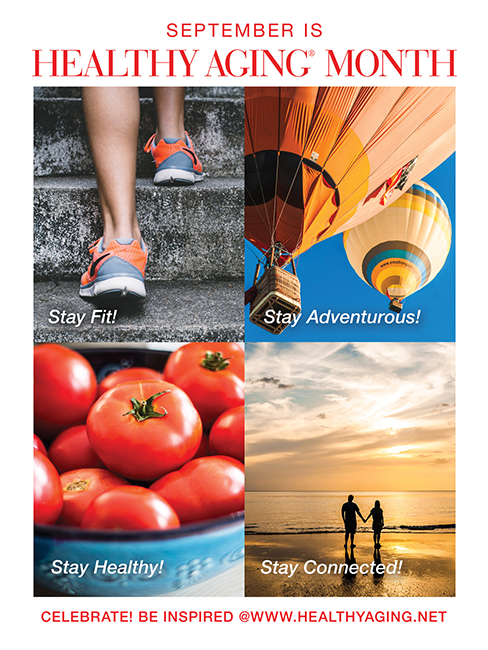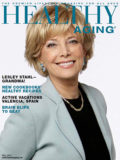 September is Healthy Aging® Month, the national observance month created by the Healthy Aging® organization over 25 years ago. Since the observance month began, there have been no greater changes in the world for older adults than what we have seen over the past several months.
September is Healthy Aging® Month, the national observance month created by the Healthy Aging® organization over 25 years ago. Since the observance month began, there have been no greater changes in the world for older adults than what we have seen over the past several months.
What has not changed? It is nows more important than ever to follow a healthy lifestyle, remain positive, be passionate about life, and to look forward to better days ahead.
Why “September is Healthy Aging® Month?”
The mission behind “September is Healthy Aging® Month” is to draw attention to the importance of healthy lifestyles for adults, 45-plus. This creates a second time during the year in addition to “May is Older American’s Month.”
When the celebration began in early 1992, the first baby boomers would be turning 50 just four years later. The general feeling then as it is now was, who wanted to be called old? Neither the baby boomers nor the generations before and after, that’s for sure.
The consensus back in the day was anyone over 50 was considered slow, out to pasture, not vibrant. But those were just myths waiting to be shattered.
Dispelling the Myths of Older Ages by Generation
Each generation is proving that many older adults are vibrant, passionate, and not the image of old age at all. From the Greatest Generation (those now over 93), the Silent Generation (those between 75 and 92), and Baby Boomers (56 to 74) to Gen-Xers (40 to 55), there are pioneers of aging determined to remain vital and healthy.
What Can You Do to Remain Healthy?
To maintain your vibrancy, why not make September the time to take stock of your lifestyle and set some healthy goals. Grab onto that old “back-to-school” feeling, and make this month a fresh start.
Celebrating September is Healthy Aging® Month During A Different Climate
For months now, we have lived under the uncertain cloud and threat of COVID-19 that has been said to be particularly targeting older adults and especially those with underlying conditions.
The facts are, according to the Centers for Disease Control (CDC), people of any age with certain underlying medical conditions are at increased risk for severe illness from COVID-19.
What are these conditions?
• Cancer
• Chronic kidney disease
• COPD (chronic obstructive pulmonary disease)
• Immunocompromised state (weakened immune system) from solid organ transplant
• Obesity (body mass index [BMI] of 30 or higher)
• Serious heart conditions, such as heart failure, coronary artery disease, or cardiomyopathies
• Sickle cell disease
• Type 2 diabetes mellitus
Many of these conditions are affected by lifestyle choices.
10 Tips for September is Healthy Aging® Month
To help you get started or keep going, here are tips from the editors of Healthy Aging®:
Diet and Nutrition
1. Check Your Diet
If you are forced to stay home more than you used to, it’s easy to throw your more structured diet plan out the window. You know what you are supposed to eat, but often it’s hard to stick to a plan. But how do you avoid gaining weight?
Consider the DASH diet, (Dietary Approaches to Stop Hypertension) created in the 1990s as a result of research by the National Institute of Health for a diet to reduce hypertension.
DASH promotes the consumption of vegetables and fruits, lean meat and dairy products, and the inclusion of micronutrients in the menu. It also advocates the reduction of sodium in the diet to about 1500 mg/day. DASH emphasizes on consumption of minimally processed and fresh food.
Another good choice is the Mediterranean Diet, said to reduce the risk of heart disease and type 2 diabetes. High priority foods to eat on this diet include vegetables, fruits, nuts, whole grains, seafood, and olive oil. Little red meat is advised and sugary foods, processed meats, and highly processed foods are excluded.
Although tempting to stockpile processed and pre-prepared foods, try to keep fresh fruits, vegetables, and meat on the grocery list.
Try a food delivery service as an alternative to going into the store yourself. GrubHub and DoorDash deliver food from restaurants to your door.
Meal delivery services are available from such groups as Home Chef, Hello Fresh, and Every Plate. You choose meal plans and the food is delivered.
Grocery delivery services rely on in-store shoppers who put together your order for pickup generally in the parking lot of the supermarket. Some deliver to your door. Examples are Amazon Fresh, Instacart and Walmart Grocery.
Physical Fitness
2. Get fit. Stay fit.
Don’t make it just like the “Freshman 15.” The existence of Covid-19 doesn’t have to include 19 extra pounds for you. Do something about it! Make it a goal to exercise at least 45 minutes a day. Walk, run, cycle – Get outdoors.
3. Track Your Activity to Help You Meet Your Goal
Some people use the “walk 10,000 steps a day” guideline to get them going. An easy way to calculate your steps is to download a fitness tracker app on your smartphone. Check out apps from Apple or Android users.
Or, you can invest in an activity tracker, a wearable that keeps track of how far you go and calories burned. Examples are models from Garmin, Apple, and Fitbit. Some measure heart rate and the quality of your sleep. Some models have GPS, play music, and are a phone all rolled into one.
4. Go Online for Fitness
Get back to your gym if you feel comfortable. If your gym is closed or you would feel less stressed working out from home, go online for classes or programs to get your heart rate up and build muscle mass. Many are free, some have subscriptions.
5. Look for Free Classes
Check your local Y for free classes or go to the national YMCA website. Choose from yoga, Pilates, weightlifting, tai chi, and a variety of active older adult classes.
6. Virtual Running Races
Virtual online running races. There are many websites offering virtual runs. You sign up and are given a course that you can do on your own time. Some of these sites even offer medals.
Run Across America: Fall 5k on Saturday, October 3, 2020, is one example. After registration, you’ll get a text with a unique code and instructions to download the new Run Across America app that we use for the event. From there you can create a team and challenge friends to join you virtually.
When it’s time for the event, you lace up your shoes and activate the race tracker in the app. It’ll let you know as you make progress toward 5 kilometers on whatever route you choose in your neighborhood. After you’re done running, you can see how you performed versus others on the leaderboard. Plus, just like a regular race, you can get a t-shirt and medal to commemorate your achievement.
7. Virtual Cycling
Zwift is an online program that blends the fun of video games with the intensity of serious training.
Zwift offers a community for runners and cyclists. For runners, you can find hundreds of events from fun group runs to more intense races with real prizes on the line. By paring with other apps like Strava and Garmin Connect, you can run laps with friends and others from around the world. For cyclists, Zwift is a chance to ride virtual roads, participate in structured workouts or jump in with social group rides. A free trial is offered for 7 days. Membership is $14.99 a month.
Mental Wellness
During these often stressful times, it is important and sometimes hard to keep spirits up. Of course, it is easy to say, “think positively,” but it’s not always easy to do.
Having a good support system and engaging with trustworthy people are key elements to successfully talking about your own mental health.
One resource is MentalHealth.gov which provides one-stop access to U.S. government mental health and mental health problems information. Content for this website is provided by Centers for Disease Control and Prevention, MedlinePlus and National Institutes of Health, National Institute of Mental Health (NIMH), and more.
Here are mental wellness tips from MentalHealth.gov:
8. Build Your Support System
Find someone—such as a parent, family member, teacher, faith leader, health care provider or other trusted individual, who:
• Gives good advice when you want and ask for it; assists you in taking action that will help
• Likes, respects, and trusts you and who you like, respect, and trust, too
• Allows you the space to change, grow, make decisions, and even make mistakes
• Listens to you and shares with you, both the good and bad times
• Respects your need for confidentiality so you can tell him or her anything
• Lets you freely express your feelings and emotions without judging, teasing, or criticizing
• Works with you to figure out what to do the next time a difficult situation comes up
• Has your best interest in mind
9. Find a Peer Group
Find a group of people with mental health problems similar to yours. Peer support relationships can positively affect individual recovery because:
• People who have common life experiences have a unique ability to help each other based on a shared history and a deep understanding that may go beyond what exists in other relationships
• People offer their experiences, strengths, and hopes to peers, which allows for natural evolution of personal growth, wellness promotion, and recovery
• Peers can be very supportive since they have “been there” and serve as living examples that individuals can and do recover from mental health problems
• Peers also serve as advocates and support others who may experience discrimination and prejudice
Social Wellness
10. Be social
Learn how to make Zoom calls if you haven’t already. Skype is another easy free app for video and telephone calls. Make it a point to reconnect with old friends using these apps if you feel more comfortable with this style of social distancing.
Feeling uncomfortable with how you look on the computer’s webcam? Invest in an outboard webcam. Relatively inexpensive, the camera and microphone combos offer higher quality imaging and sound.
Join Zoom or other online groups with people you know and that meet regularly. Look into virtual church services. Stage a virtual cocktail party with old friends. Set up an online book club. Join a garden club online.
The TakeAway
Stay positive. Try to think beyond yourself. Sure, these are complicated, unsettling times but you can use these days to work on your own health as well as to support your friends, neighbors, and family.
Now more than ever is it important to have a positive outlook. It will serve you well not only during September is Healthy Aging® Month but as you move forward.
For more information about healthy lifestyles, subscribe to Healthy Aging Magazine. Special discounts for group subscriptions













